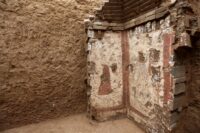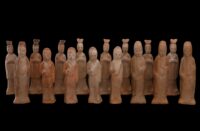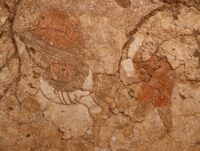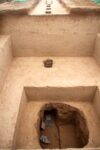 Two Tang Dynasty (618-907) tombs with surviving murals were unearthed in northwest China’s Shaanxi Province. Archaeologists from the Shaanxi Provincial Institute of Archaeology discovered the tombs last month in Buli Village, 25 miles from Xi’an, the capital of Shaanxi Province today and the ancient capital of China during the Tang Dynasty. The tombs are intact with inscriptions identifying the owners and the murals, while damaged, contain imagery that is extremely rare in Tang Dynasty art.
Two Tang Dynasty (618-907) tombs with surviving murals were unearthed in northwest China’s Shaanxi Province. Archaeologists from the Shaanxi Provincial Institute of Archaeology discovered the tombs last month in Buli Village, 25 miles from Xi’an, the capital of Shaanxi Province today and the ancient capital of China during the Tang Dynasty. The tombs are intact with inscriptions identifying the owners and the murals, while damaged, contain imagery that is extremely rare in Tang Dynasty art.
 One of the tombs contained the remains of a Tang Dynasty official. The single-occupant tomb was made of brick, encircled by a ditch and sealed with soil. It is oriented north to south and is 140 feet long with a sloped passage leading into the burial chamber. Archaeologists have found 102 funerary figurines, most of them depicting riders on horses, some standing individuals placed in niches.
One of the tombs contained the remains of a Tang Dynasty official. The single-occupant tomb was made of brick, encircled by a ditch and sealed with soil. It is oriented north to south and is 140 feet long with a sloped passage leading into the burial chamber. Archaeologists have found 102 funerary figurines, most of them depicting riders on horses, some standing individuals placed in niches.
The interior east and west walls are painted with a mural of caravan led by  a blue dragon and a white tiger. Huren (a broad term meaning northern barbarians used by Chinese chroniclers to describe the nomadic peoples who were conquered and absorbed under the dynasty’s second emperor, Emperor Taizong of Tang (r. 626-649)) are depicted training horses and leading camels. Horses, canopies and attendants armed with bows and arrows follow. Below them are hunting hounds lying down, looking up at the caravan and running.
a blue dragon and a white tiger. Huren (a broad term meaning northern barbarians used by Chinese chroniclers to describe the nomadic peoples who were conquered and absorbed under the dynasty’s second emperor, Emperor Taizong of Tang (r. 626-649)) are depicted training horses and leading camels. Horses, canopies and attendants armed with bows and arrows follow. Below them are hunting hounds lying down, looking up at the caravan and running.
The quality of the painting is high with fine pigment and smooth brushwork. The people and animals are captured in dynamic movement. Horses and hunting dogs were very rare subjects for murals in Tang Dynasty tombs, and the epitaph explains their presence: the deceased, Kang Shanda, was the supervisor of horses under Emperor Gaozong (649-683). His father had held the same position and the family was very wealthy, rich in, the inscription says, cattle, horses and hidden treasures. He died in 671.
 The second tomb is a joint burial of two royal family members. It is 110 feet long, north to south, cut out of the earth. The four walls of the chamber are decorated with murals. The raw soil walls were whitewashed and painted with scenes of feasting. One wall features dancers standing in the middle between two groups of musicians. Another mural features a table with dishes of food placed along it.
The second tomb is a joint burial of two royal family members. It is 110 feet long, north to south, cut out of the earth. The four walls of the chamber are decorated with murals. The raw soil walls were whitewashed and painted with scenes of feasting. One wall features dancers standing in the middle between two groups of musicians. Another mural features a table with dishes of food placed along it.
The epitaph identifies this tomb as that of Yang Zhishi and his wife from the Pangda family. Both the Yang and the Pangda families married into and were related to the imperial families of the Wu, Zhou and Tang imperial dynasties.
A mural depicting a scene of music and dance in the second tomb, owned by a royal couple, is in the typical style of the golden age of the Tang Dynasty.
The discovery of the two tombs has provided new materials for the study of murals and social customs at the time….
Wait. Blue bricks?
Yes Jim, as in ‘If a red house is made of red bricks, a blue house is made of blue bricks and a yellow house is made of yellow bricks, what is a greenhouse made of?’.
Aerated concrete blocks used to be noticeably blue, I think because they used to include slate in the ingredients.
One of the reasons I enjoy your blog so much is the wide variety of countries and “ages” that you post.
Thank you..
Obviously, a blatant case of overambitious *tomb sweeping, and maybe it should be pointed out that the plural of the term ‘Hure‘ is not to be confused with ‘Húrén‘ (Zhuyin ㄏㄨˊ ㄖㄣˊ), the Pinyin transcription of 胡人, i.e. historically the Northern and Western barbarian tribes of Ancient China.
The term ‘Záhú‘ is apparently a synonym, i.e. 杂胡 as the simplified form of 雜胡, and would possibly make it more clear. Notably, a simplified form of the other term, over here in the Ghetto, would be ‘hoe‘. The (Dutch) verb ‘verhuren‘ means ‘to rent’ (cf. ‘hire‘), to grant occupation in return for rent, or –in this context– what ..well.. some refer to as ‘terminate marriage‘.
:hattip:
—————–
(*) The ‘Qingming festival‘, also known as ‘Tomb-Sweeping Day‘ in English, is a traditional Chinese festival on the first day of the fifth solar term of the traditional Chinese lunisolar calendar. This makes it the 15th day after the Spring Equinox, either 4, 5 or 6 April in a given year. Chinese families visit the tombs of their ancestors to clean the gravesites, pray to their ancestors and make ritual offerings. Offerings would typically include traditional food dishes and the burning of joss sticks and joss paper. The holiday recognizes the traditional reverence of one’s ancestors in Chinese culture and has been observed for over 2500 years. It became a public holiday in mainland China in 2008.